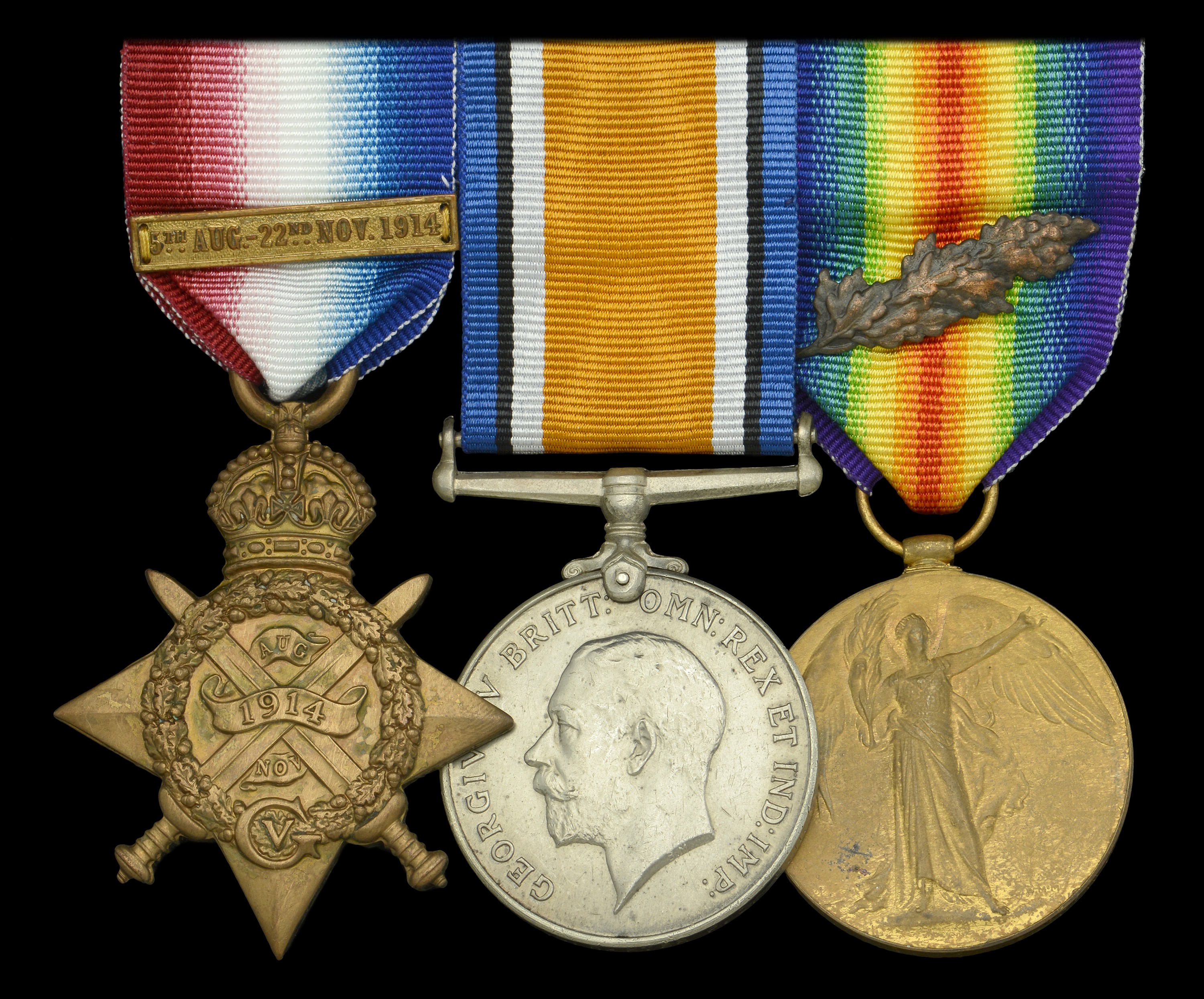The Great War group of three awarded to Petty Officer G. Baxter, Royal Navy, attached Armoured Trains 1914 Star, with clasp (206500 G. Baxter, P.O. Armd. Trains.); British War and Victory Medals, with M.I.D. oak leaves (206500 G. Baxter. P.O. R.N.) the last with very faintly impressed naming, good very fine (3) £400-£500 --- Importation Duty This lot is subject to importation duty of 5% on the hammer price unless exported outside the UK --- --- Provenance: Spink, April 1999. M.I.D. London Gazette 17 April 1918. 77 1914 Stars issued for service with Armoured Trains. George Baxter was born in Bristol, Gloucestershire on 4 March 1883, and entered the Royal Navy as a Boy 2nd Class in September 1899. Having then witnessed extensive seagoing experience in the interim, he was discharged as a Petty Officer ‘time expired’ in March 1913. Recalled in September 1914, Baxter was quickly re-employed in land operations in armoured trains and posted to H.M.A.T. Churchill. Three heavy armoured trains were built in Antwerp in September-October 1914, mounted with British naval guns, and placed under the overall command of Commander A. S. Littlejohns, R.N., with Lieutenant-Commander P. H. Riddler, R.N., as his second-in-command. Known from 9 November as H.M. Armoured Trains Jellicoe (Commander Littlejohns) with three 4.7-inch guns, H.M.A.T. Déguise (Belgian Captain Servais) with three 4.7-inch guns, and H.M.A.T. Churchill (Lieutenant-Commander Riddler) with two 6-inch guns, these three armoured trains fought around Antwerp until 7 October, then retreated via Ghent, in support of General Rawlinson’s advance to Ypres. H.M.A.T. Churchill became operational at Oostende after the retreat from Antwerp and in December went into action in the area around Oostkerke against German batteries to the south of Dixmude. From the end of December 1914 to March 1915, the three trains were continuously in action, sometimes in support of an assault (Jellicoe at la Bassée on 10 January), but in particular in counter-battery or bombardment missions in action to neutralise trench lines. Hence Jellicoe in action at Beuvry 20-24 January, Churchill at Oosterkerke on 28-29 January, and against an observation post at Ennetieres on 11 February, Déguise at Beuvry firing on a rail junction on the 15th, among other targets, and Churchill against a battery at Fleur d’Ecosse on 3 March. The guns of the trains were extremely effective, notably against troop concentrations. On 18 February, H.M.A.T. Déguise fired seven shells at German troops to the South-West of La Bassée. These actions brought the trains within range of the German artillery. The Germans scored hits, but the armour protection and swift manoeuvring of the trains normally protected the crews, except on 25 January when Jellicoe was hit, wounding two men and killing the Belgian engine driver. Between 10 and 13 March, the three trains supported the action at Neuve Chapelle. On that occasion, Field Marshal Sir John French paid a surprise visit to H.M.A.T. Churchill, which was the command train for Commander Littlejohns. Towards the end of March 1915, the three trains were withdrawn from service. Baxter’s subsequent appointments included the minesweeping sloop Alyssum from December 1915 to February 1916, the Queenstown depot Colleen and the Grimsby base Pekin, and he was demobilised in March 1919.
Auctioneer's Buyers Premium: 24% (+VAT)
There is an additional charge of 4.95% (+VAT/sales tax)
See Full Terms And Conditions





